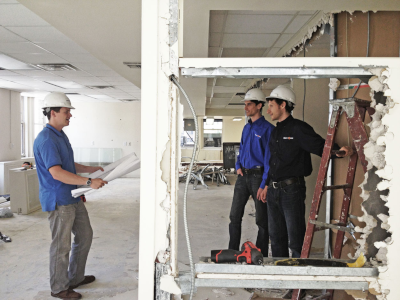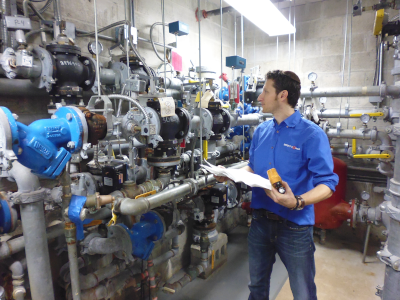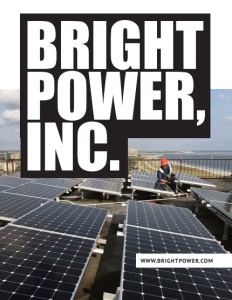Bright Power, Inc.
Intelligence-driven energy management
Business View Magazine interviews Jeffrey Perlman, Founder and President of Bright Power, for our focus on Fastest Growing Energy Companies.
Bright Power, Inc. provides energy management services ranging from energy benchmarking, auditing and energy procurement, to turnkey resiliency solutions and energy saving building improvements. Founded in 2004, this intelligence-driven firm serves building owners and managers throughout the U.S. from its headquarters in New York City, and a second office in Oakland, California. Putting a tangible solution to climate change is the mission that propels Bright Power forward and has landed it on the Inc. 5000 list of Fastest Growing Companies in 2018 for the third time.
Bright Power began by delivering energy and water improvements to multifamily and commercial buildings but kept running into gaps where money, time, and resources were being wasted – despite everyone’s best intentions. In the process of solving these problems, a unique company was created with deep expertise in every dimension of energy and water management, gaining recognition as “go-to” green building experts.
Business View Magazine recently had a candid discussion with Jeffrey Perlman, Founder and President of Bright Power, who has turned his expertise and passion for environmental preservation into a thriving business that is changing cityscapes and doing its part to save the planet. The following is an edited transcript of that conversation.
BVM: How did Bright Power come into being?
Perlman: “I started the company at the end of 2004, after having previously done consulting and high-level analysis on the costs and benefits of green buildings. I was always very interested in the industry. In college, a group of us spent a bunch of time outside of class designing and building a solar-powered car. After college, I worked with a company installing solar panels. I saw there were opportunities to put renewables on buildings, particularly solar, but at that time solar panels prices were much higher than they are today. So, I started learning about all of the energy waste in typical buildings, and how to make buildings run more efficiently with better economic returns than were possible with solar at that time.
“My initial idea was to marry these things together. I started working with building owners to make an economic case for both efficiency and renewables in New York City buildings. That was the concept, but we didn’t have a particular market niche we were working with – just talking to whoever would listen. I was 25 and had more gumption than experience. But after a couple years, I began to understand the architectural landscape of NYC and that the vast majority are apartment buildings.
“So, we focused on multi-family/apartment buildings, even though a lot of other energy efficiency companies were only doing commercial, municipal, and industrial projects. We also started working with affordable housing, where we could have a powerful social impact, in addition to the environmental impact, keeping the cost of housing down for those who can least afford to pay any additional for it – whether saving energy in somebody’s apartment, so their bills are lower, or reducing consumption in the building as a whole and therefore cutting operating expenses and preventing the need to raise rents. Today, most of our work is split evenly between affordable housing and market-rate housing with a small percentage that doesn’t pertain to apartment buildings like commercial offices, hotels, universities.
“About ten years ago, we started working with groups that had national housing portfolios and realized that when you get out of NYC, where there isn’t the density of apartment buildings, there were even fewer companies focused on making those types of buildings operate more efficiently. Having cut our teeth in NYC, the epicenter of apartment buildings, we learned that the expertise we’d developed there allowed us to offer what we do across the country.”
BVM: Who are your typical customers?
Perlman: “We work primarily with building owners. On the market-rate multifamily side, we work with asset managers, heads of sustainability, and heads of investment at REITs (real estate investment trusts) as well as their property management companies. On the affordable housing side, we work with owners and developers, both non-profits and for-profits. Most of the affordable housing is privately owned, and we also liaise with government agencies that provide tax credits, low-cost mortgages, etc., for those owners. We have a number of services that we offer nationally – energy analysis, evaluation, recommendations, procurement, measurement, and reporting. When it comes to providing turnkey implementation and construction services, the majority of that work is in the New York metro area and California.
 “Bright Power started as a consulting firm to real estate owners, giving advice on how to reduce energy usage and install solar panels. Once people began trusting us, they’d ask if we could do the work for them. So, we first hired sub-contractors, and now with our own team of experienced installation and construction professionals as well, we have the ability to implement the projects that we recommend. In all, we have over 130 employees. In the last couple of years, the installation business has grown a lot, so that the majority of our revenue is through construction of rooftop solar arrays or energy efficiency upgrades – boiler improvements, HVAC, lighting, water fixtures. These are projects we identified and recommended, then designed and installed. It’s not just the physical implementation, but also understanding the various incentives and subsidies available from the government and utility companies that can help with costs or extend the amount of work an owner can do. And we don’t stop with installation – once the upgrades are installed we measure and verify the results, and provide an ongoing energy management service to ensure that the systems continue to run at peak efficiency.”
“Bright Power started as a consulting firm to real estate owners, giving advice on how to reduce energy usage and install solar panels. Once people began trusting us, they’d ask if we could do the work for them. So, we first hired sub-contractors, and now with our own team of experienced installation and construction professionals as well, we have the ability to implement the projects that we recommend. In all, we have over 130 employees. In the last couple of years, the installation business has grown a lot, so that the majority of our revenue is through construction of rooftop solar arrays or energy efficiency upgrades – boiler improvements, HVAC, lighting, water fixtures. These are projects we identified and recommended, then designed and installed. It’s not just the physical implementation, but also understanding the various incentives and subsidies available from the government and utility companies that can help with costs or extend the amount of work an owner can do. And we don’t stop with installation – once the upgrades are installed we measure and verify the results, and provide an ongoing energy management service to ensure that the systems continue to run at peak efficiency.”
BVM: How do you evaluate energy usage in a building?
Perlman: “Our customers often own several buildings, and when we asked why they chose a certain one for us to work on, it was either they’d just bought it, or wanted to sell it, or it was the building they were spending the most money on. They had little framework for evaluating and understanding energy and water usage. So, in 2010, we released EnergyScoreCards, Bright Power’s proprietary software as a service (SaaS) product that takes in utility bill and building information and compares it to a larger dataset of buildings. Today, we have over 35,000 buildings in that database, so we can see whether an apartment building is a good or poor performer in comparison. There are also sub-categories for areas like heating and cooling, water heating, and lighting. It’s a great energy performance evaluation tool. We also provide a dedicated Energy Analyst with each subscriber to help them to understand the data and turn it into actionable next steps.
“The best way to describe the services of our company is that we Find areas of waste and opportunity, Fix buildings to operate more efficiency, and Follow the data to ensure each project is meeting investment goals. The Find phase involves engaging with a portfolio – gathering all the building information plus utility bills and energy usage; analyzing it; and prioritizing the focus on the buildings with the best opportunities. The Fix phase starts with sending engineers into the building to evaluate specific systems. Then we put a scope of work together, iterate that with the owner, look at what incentives are available, and finalize what to do. Then we implement it. Follow is the final step. It can be as light a touch as the EnergyScoreCards platform, which is analysis based on monthly utility bills to provide guidance on performance and whether we should intervene to improve it. That’s the most basic level. Then we have MoBIUS, our ongoing and continuous energy and water management service, where we watch the building in real time and generate alerts based on sensor and meter data. It enables us to react much more quickly to any changes, so operations run smoothly, tenants are comfortable, and headaches are kept to a minimum.”
Jamil Ellis, Bright Power’s CTO, adds, “Our technology team built the original EnergyScoreCards and MoBIUS software, and we continue to build new features and maintain those we have. We are always pushing the boundaries in technology for buildings, and that type of work is done in-house.”
BVM: What sets Bright Power apart from competitors?
Perlman: “There are some similar software solutions to ours, but they don’t actually engineer or deliver any of the improvements indicated by the data. There are also engineering firms focused on energy efficiency that will do an energy study and give recommendations, but many don’t implement the work. We do the whole package. That’s a real differentiator and a breath of fresh air for our clients. We give a turnkey approach, where we give recommendations, a real cost, and we implement the project.
 “We also work with developers on new apartment buildings. In those situations, we’re part of the design team. There’s an architect, an engineer, a developer, and we play the sustainability role. Managing green certifications like LEED, Passive House, and ENERGY STAR is a component of what we do on the team. We also work to incorporate renewables into the design, for example, the amount of shade impacts where you can put the solar panels. That design team role has become a growing part of our business with all the new construction in New York City. And we can provide particular value to the new construction teams because of our experience diagnosing and fixing the problems with existing buildings – we can help them avoid the mistakes we’ve seen others make.”
“We also work with developers on new apartment buildings. In those situations, we’re part of the design team. There’s an architect, an engineer, a developer, and we play the sustainability role. Managing green certifications like LEED, Passive House, and ENERGY STAR is a component of what we do on the team. We also work to incorporate renewables into the design, for example, the amount of shade impacts where you can put the solar panels. That design team role has become a growing part of our business with all the new construction in New York City. And we can provide particular value to the new construction teams because of our experience diagnosing and fixing the problems with existing buildings – we can help them avoid the mistakes we’ve seen others make.”
BVM: What is the future goal for Bright Power?
Perlman: “We’ve been growing quite rapidly. The big challenge is making sure we have good structures in place to deliver the quality of work that people have come to expect from us as we continue to scale, and that we can support more managers, engineers, and staff. There are a lot of promising trends in the marketplace; solar prices have come down in many states and the economics look good. I’m really excited that the word is getting out there that energy usage impacts the financial performance, and therefore the value, of real estate. Government-sponsored enterprises (GSEs) Fannie Mae and Freddie Mac now have green retrofit programs that provide better terms on mortgages for properties that are making energy efficiency improvements at the time of refinancing.
“Our goal is to make it easier for companies that own and manage real estate to have buildings that are energy and water efficient and comfortable, using clean energy and as little water as possible. We’re always looking for ways to incorporate creative financing for energy upgrades and unify our analysis, engineering, and construction services, so our customers can engage more easily and get even more value from our Bright Power services.”
Check out this handpicked feature on Stiebel Eltron – Make it right, keep making it better.
AT A GLANCE
WHO: Bright Power, Inc.
WHAT: Intelligent energy management solutions
WHERE: New York, NY
WEBSITE: www.brightpower.com




